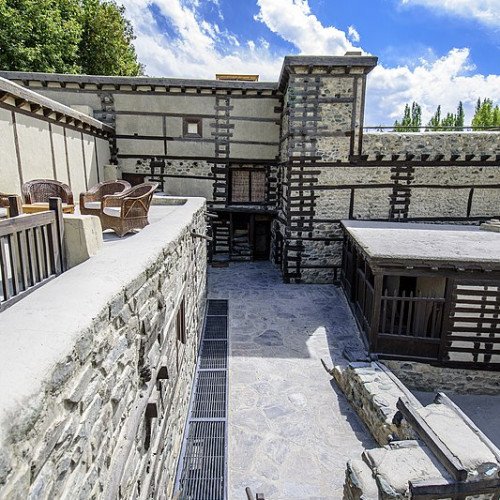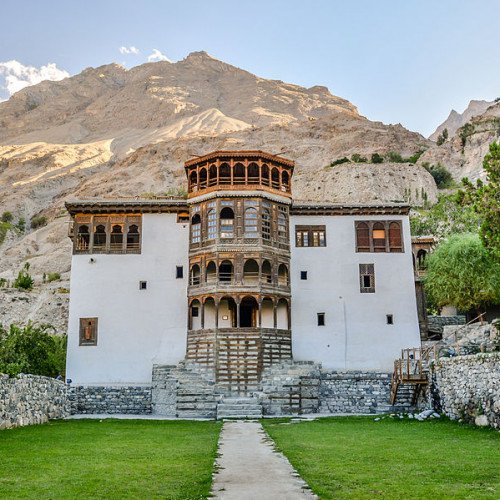Castles of "Pakistan" SHIGAR FORT vs KHAPLU PALACE

SHIGAR FORT
The Shigar Fort (Balti and Urdu: فونگ کھر) means The Fort on Rock is an old fort of Baltistan and Pakistan located in the town of Shigar. It was built in the 17th century by the Raja of Amacha Dynasty of Shigar. The fort has been restored by Aga Khan Cultural Service Pakistan (AKCSP-P), the Pakistan arm of the Aga Khan Historic Cities Programme. After restoration, the Fort was converted to a museum and luxury hotel managed by Serena Hotels. The restoration process took place from 1999 to 2004 and cost approximately US$1.4 million. The original Fong-Khar was founded on top of a platform which rises 5m from the ground and partly surrounds a gigantic cone-shaped rock (thus, the origins of the name, Fong-Khar, or “Palace on the Rock”). Although the Old Fort-Palace as it is now restored appears to be one structure, upon closer examination, it is actually a collection of three separate buildings, built adjacent to each other in different times and with different engineering and workmanship. During the restoration of the site, these three structures were identified as Modules I, II, and III. Module I is the oldest part of the original structure estimated as being 400 years old. It can easily be interpreted as a single, clearly conceived and executed structure, with a distinct and noble architectural expression. Original usage of this structure can be identified through its sequence of rooms including entrance hall, grand audience hall, retiring rooms for the ruler, and kitchen. Module II is estimated to have been constructed approximately 100 years after the original Fong-Khar, with Module III following another 150 years later. Both Modules II and III were composed of residential rooms for the royal family, some more elaborate than others. The building to the south of the Old Fort-Palace is now known as Old House. Its lower floor had accommodated a horse stable, a cattle pen, and storage for animal feed. It appears to have existed as the royal stable for as long as Fong-Khar itself. The upper floor of this structure was added much later by the raja as new residential accommodation when the Old Fort-Palace was abandoned in the middle of the 20th century.
Statistics for this Xoptio

KHAPLU PALACE
Khaplu Palace (Urdu: خپلو محل; Balti: ڈوقسہ کھر), locally known as Yabgo Khar (meaning "The fort of Doqsa"), is an old fort and palace located in Khaplu, in the Gilgit-Baltistan region of northern Pakistan. The palace, considered an architectural heritage and a tourist attraction, was built in the mid-19th century, replacing an earlier fort located nearby. It served as a royal residence for the Raja of Khaplu. From 2005 to 2011 the palace, having earlier stood in vulnerable conditions, underwent a restoration project carried out by the Aga Khan Trust for Culture under the Aga Khan Historic Cities Programme. The palace now houses a hotel operated by Serena and a museum depicting the history and culture of Baltistan. Khaplu Palace was built in 1840 by the Yabgo Raja Daulat Ali Khan of Khaplu after the Dogra of Kashmir who captured the region decided to move the seat of government from the old fort. The site of the palace was chosen by rolling a large stone down from a nearby cliff; it stopped at the Doqsai village, and the palace was built there. The earlier fort was located near the location of the present-day palace. Khaplu Palace replaced the former fort as the royal residence after its completion. According to Jane E. Duncan, the people of Khaplu used to live inside this fort and were not allowed to build their homes outside its premises. This practice was changed after Maharaja of Kashmir took control of the area, resulting in a cessation of conflict among neighbouring rulers. The former fort was captured by Murad Khan of Maqpon Dynasty, the ruler of Baltistan, in the Conquest of Khaplu in the 1590s by cutting off the water and other supplies to the fort. The troops of Murad besieged the fort for three months, resulting in the surrender of Rahim Khan, the 62nd Yabgo dynasty ruler of Khaplu. The fort again fell to invaders in the 1660s and 1674. The Yabgo descendants continued to live there even after their kingdom was abolished in 1972. The last Raja of Khaplu who lived in the house was Raja Fatah Ali Khan, who died in 1983.